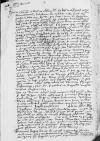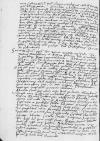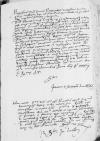1533-11-14⌊Hesterno die1533-11-14⌋ redditae mihi sunt ⌊⌋ Paternitatis Tuae Reverendissimae, quae datae erant in ⌊Antiquo Castro⌋ suo partium ⌊Prussiae⌋ 1533-10-14⌊14 Octobris1533-10-14⌋ una cum annexis ⌊⌋ suis ad ⌊magnificum dominum Cornelium⌋, nostrum communem amicum, ac aliis ad ⌊Ulricum Ehinger⌋, quae mihi gratissimae fuerunt maximique solacii. Cum autem dominus ⌊Cornelius⌋ noster ante illius hinc discessum manu sua satis prolixe ⌊⌋ Tuae Reverendissimae Dominationi de rebus per ipsum ⌊Constantinopoli⌋ gestis, nolui eidem meis ineptiis denuo molestiam inferre. Pacem attulit et illius confirmationem atque dominum ⌊Aloysium Griti⌋ de mense Februarii adventurum pro confinibus designandis nuntiavit. Itaque a ⌊serenissima Romanorum etc. regia maiestate⌋ liberaliter condonatus, videlicet catena aurea quingentorum ducatorum ponderis ac trecentis ducatis in pecunia numerata denique pensione annua ducentorum florenorum ad vitam duratura praeter vestes purpureas et alias sericas.
Die X-ma Octobris per postas recessit ex ⌊Vienna⌋ iturus ad ⌊caesaream maiestatem⌋. Ego ob ⌊Griti⌋ adventum cogor hic subsistere, spero tamen dominum ⌊Cornelium⌋ ad me brevi rediturum. Quod an ita futurum sit vel ne, intellegam ex primis litteris ⌊caesareae maiestatis⌋, tum Dominationi Tuae Reverendissimae indicabo. De novitatibus ex ⌊Dania⌋ gratias habeo plurimas. Iussu Dominationis Tuae Reverendissimae litteras ad ⌊Cornelium⌋ datas aperui et legi, postea meo sigillo obseravi et fideliter mittam illas atque alias ad ⌊Ulricum Ehinger⌋ destinatas. Hic die 8 Octobris ex ⌊Augusta⌋ recessit versus ⌊Hispaniam⌋.
Ego ex ⌊Dania⌋ aliquando litteras accipio, nihil tamen audio, quod episcopi regni taliter afficiantur principe Orangiae, quod illum in regem eligere decreverint. Utinam Deus omnium rerum director ⌊Danis⌋ tam bene vellet et eorum cordibus gratiam infunderet, quo tam dignum principem regno praeficerent.
Altera filia ⌊regis Christierni⌋, ⌊Christina⌋ nomine, secundogenita, nupta est ⌊Mediolani duci⌋. Dominus ⌊de Praet⌋ ob id venit in ⌊Flandriam⌋, ut illam de mense Februarii abducat eamque suo marito consignet.
Cui autem altera, videlicet primogenita seu potius natu maior ⌊Dorothea⌋ nubetur, adhuc nos nihil certi hic habemus neque verbum quidem audivimus de principe Orangiae. Utcumque sit, fiat, quoddam bonum visum est in oculis Domini.
Proceres ⌊regni Daniae⌋ de mense Septembris praeterito miserunt suos oratores ad ⌊serenissimam dominam Mariam Hungariae⌋ etc. reginam pro pace impetranda et confirmanda
cum ⌊caesarea maiestate⌋, quam obtinuerunt dignis etiam condicionibus pro utraque parte. Similiter ⌊Christiernus dux Holsatiae⌋, filius quondam ⌊Frederici ducis⌋, suo et fratrum suorum nominibus fecit; qui satis aequis condicionibus ⌊caesari⌋ addictus et pensionarius suae maiestatis effectus est. Eo modo ⌊Lubicenses⌋ relicti sunt soli in bello. Quid futuro vere sequetur, tempora docebunt et rei exitus. Ego mallem rem illam bonis et aequis mediis ad tranquillitatem transigi, quam extremo belli periculo, quamquam ⌊Hollandi⌋, iam accensi in ⌊Lubecenses⌋, multa milia pro bello incepto continuando offerunt. Ornarunt classem XXI navibus et admiraldus classis est nobilis quidam et aulicus domini de Beveres, ⌊Mekeren⌋ nomine, qui annis elapsis in bello contra ⌊Gallos⌋ satis strenue se gessit. Existimo illum Dominationi Tuae Reverendissimae notissimum fore. Militibus autem praeest dominus ⌊Cristophorus comes de Oldemborch⌋.
Sanctissimus
dominus noster ⌊pap⌋a die nona recessit ex ⌊urbe⌋ Roma iturus ⌊Marsiliam⌋ in ⌊regno Franciae⌋, ubi iam dudum a ⌊Gallorum rege⌋ exspectabatur. Abduxit secum ⌊neptem suam⌋ ex ⌊Laurentio de Medicis⌋ prognatam, quam nupsit secundo genito filio ⌊⌊regis Franciae⌋, duci Aureliano⌋.
Sanctitas sua pollicetur multa et magna se pro communi pace Reipublicae Christianae facturam. Multi sunt Thomae fidei. Ego, quid sentiam, nescio, quam quod de sanctissimo optima speranda sunt (si nomen conveniat rei) et Deum continuo invocandum censeo et rogandum, quo suam gratiam impartiri et corda omnium principum, praesertim regum christianorum, ad se trahere et unire dignetur. Alioquin timendum erit, ne tota Respublica Christiana maximo rerum omnium periculo illabatur.
Advecta sunt hic nova ante dies quattuor marchionem Guaste cum Hispanis militibus, qui ex Corone redierint, urbem Romam intravisse, absque tamen tumultu et alicuius incommodo. Item quod Anchonitani cives, qui anno superiore a pontifice solita libertate privati et illius imperio immediate subiecti facti sunt, saevierint in praefectos eis a pontifice destinatos erectoque vexillo et armis sive insignibus caesareis clamitarint: Liberta, liberta, Carolo, Carolo, imperio, imperio; de his litterae huc missae sunt. Regia tamen maiestas dicit se nihil certi habere. Nihilominus rumor ex multis partibus et a diversis provinciis et personis in dies augetur. Ob id nolui haec pro re certa scripsisse. Cum primum tamen rei certitudinem accepero, Dominationem Tuam Reverendissimam per meas litteras admonebo.
Magnificus dominus comes ⌊Nogarollus⌋ rectissime valet. Quem crastina luce ad prandium invitabo et iniunctum mihi negotium fideliter exsequar.
Dominus ⌊Hieronimus Laski⌋ ex ⌊Constantinopoli⌋ rediit, post cuius reditum, nescio, quid inter ip{i}sum et Ioannem comitem Scepusiensem, quem vayvodam vocant, alii regem, interciderit. Non satis bene conveniunt. Unde idem ⌊Hieronimus⌋ cum indignatione dimisit vayvodam ac cum regiis tractare incepit.
⌊Serenissima Romanorum etc. regia maiestas⌋ statuit die Iovis proxima hinc abire versus ⌊Pragam⌋ et subsequor continuo aulam. Quae veriora de his et aliis occurrunt, et rescribere liceat, Dominationi Tuae Reverendissimae perscribam. Quam scio pro innata prudentia ac summo illius in me amore omnia etiam inconsiderate et inepte scripta in meliorem partem interpretaturam, cuique me tamquam patri honorandissimo ex toto corde et affectuosissime commendo.



